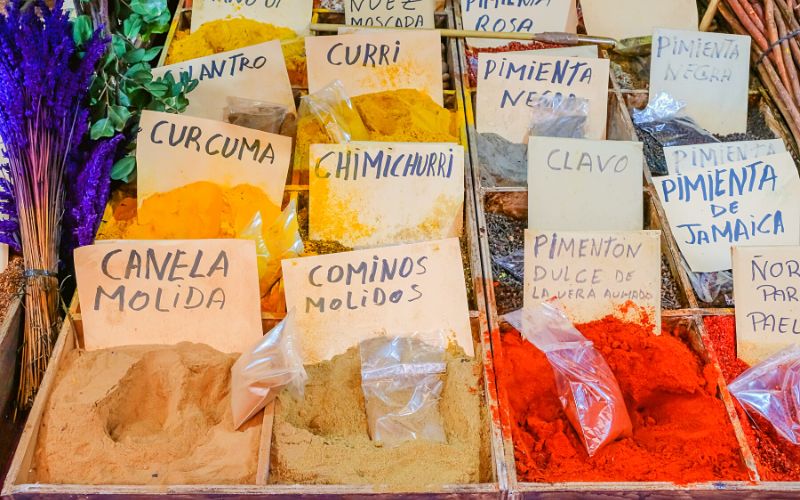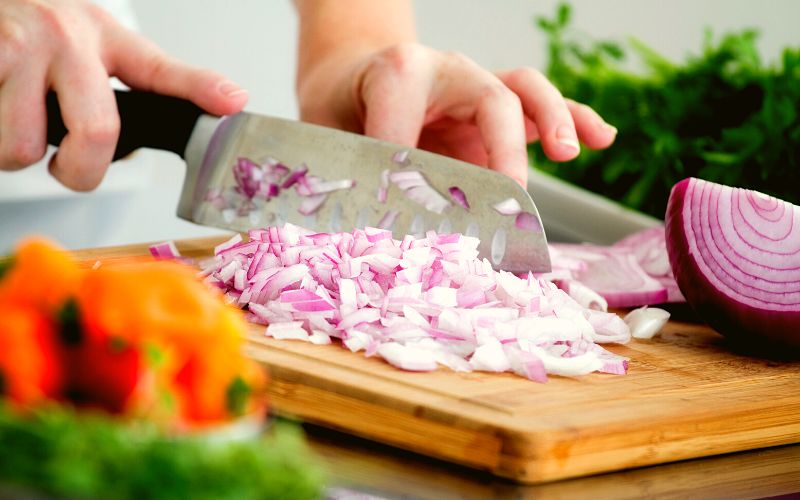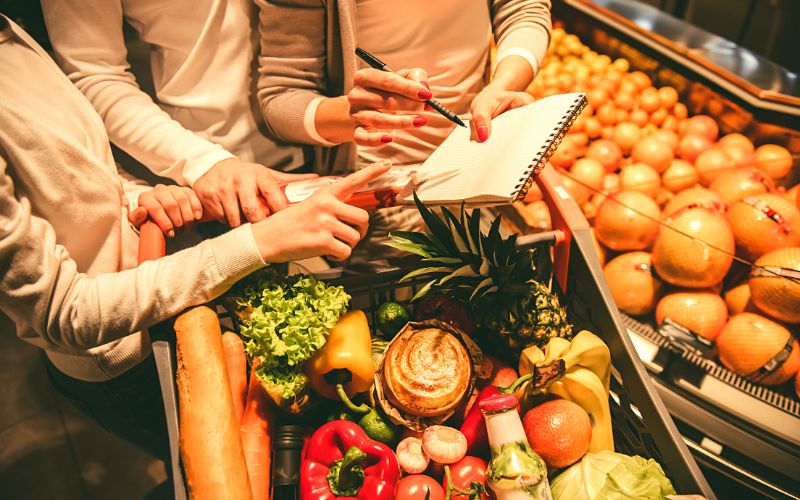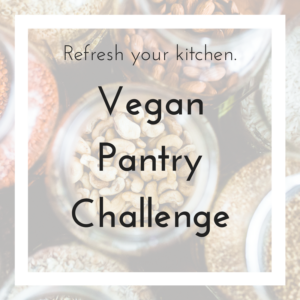Rising food costs are a concern for most households these days. How to save money on healthy vegan food? I propose a strategy that goes deeper than perusing flyers. Warning: mindset shifts ahead.
Ask where your (food) money going
How much of your money are you spending at grocery stores (and which ones), how much at the restaurant, and how much on coffee and treats at the drive-through?
Tracking my family’s expenses systematically has transformed my life and I bet it will transform yours, too. You can join the fun by keeping your receipts, jotting down your spending every day, and breaking down your spending into relevant categories. Categorize every dollar you spend. Do it for at least two weeks, preferably a month… or continue for life!

There are different ways to break down the categories. Groceries vs. eating-out is perhaps the simplest way, but getting a little more granular might provide fresh insight. For example, how much money are you spending on ingredients you will cook compared with convenience, ready-to-eat food products? Within the “eating out” category, how much is for entertainment (a nice meal out with your special someone) and how much is for convenience (ordering pizza because you don’t feel like cooking)?
How are the dollars you spend serving you? Are you happy with the audit is telling you? If not, what would you like to tweak?
Beyond food, consider tracking your spending in general. Though you might have felt the squeeze more acutely at the grocery store, there might be other ways your money flies out of your wallet that, upon careful examination, don’t feel meaningful or worth it compared to nurturing your health with healthy vegan food.
We use the YNAB app (You Need A Budget… yes, you do!) which allows us not only to know where the money is going, but also to “give jobs” to the new dollars we earn when they come in. It has made us a lot more mindful of how we spend our money, including for food. I hear that a similar system, but using actual cash and envelopes, has grown popular with younger people.
Know what you have in stock… and plan to use it!
When was the last time you saw the back of your pantry shelves and the bottom of your freezer? It’s probably time for a thorough inventory and clean up.
Start with your pantry, then the fridge, then the freezer. For each, take everything out, wipe the shelves clean, and carefully examine every item. Is it spoiled or so far past its prime that it will taste nothing? Let go of the guilt and throw it away. If you have multiple containers of a given ingredient, consolidate into one so you can better track your supply. As you hold the ingredient in your hands, remember what you bought it for, and visualize how you will use it in a dish in the future. Maybe jot down ideas for your next meal plan.
Put older items that should be eaten soon, or “feature ingredients” that you want to remember using more often, closer to the front or top so they don’t get forgotten again.
Make a pantry challenge of it! Commit to not buying any new food for the coming week or two, using stock you have instead. In many cases, those ingredients will need to be replenished, but chances are you also will eat many things that would have gone to waste otherwise. My Vegan Pantry Challenge free printable kit of templates will help you with the inventory and provide suggestions to improvise meals from what you find.
Learn to improvise the most common healthy vegan dishes
Let’s say you found pinto beans. You might be tempted to pull out your phone and type this in the search bar: +vegan +recipe +”pinto beans”.
Don’t do it!
I know that, deep down, you know what to do with pinto beans. Close your eyes and think for a minute.
If the beans are dry, cook them up. Otherwise, open the can. Add them to a soup or stew. Cook them with onion and garlic, add some seasonings that you just found, and serve with rice and steamed greens. Toss them into a salad. Roll them up in a burrito. Use what you have! Even if it doesn’t look like much, you can’t go wrong with good ingredients like pinto beans.
If you find ingredients that are less obvious to you, say chickpea flour, you have my blessing to look for recipes… but don’t actually follow them! If you were to do that, you would likely find yourself having to buy new ingredients, defeating the purpose of all the work you’ve done so far. Instead, read the recipe to understand how the ingredient is used, and then experiment with substitutions based on the ingredients you have at hand.
Psst! For chickpea flour, smell it to make sure it’s not rancid, then mix with some water (start with a small quantity and add more until you have a thick but pourable batter) and seasonings (things like garlic powder, turmeric, ground pepper, cumin, turmeric, black salt, smoked paprika…), plus maybe a half teaspoon of baking powder. (Not absolutely necessary.) You have yourself the base of a vegan omelet or thin chickpea crepes!
Plan your meals
Before you hit the store, you must have a plan. Dinner time is no time for decisions, so find a time in the week when you can dedicate brain cycles to what you are going to eat. Plan simple meals that reflect your priorities – it may require conscious compromises – without breaking the bank. Do glance at the flyers because they tend to give good hints about what fresh vegetables and fruit are currently in season, abundant, and less expensive. Keep track of prices-by-weight from one week to the next so you are not so easily fooled. Create a grocery shopping list and commit to sticking to it. Use my Vegan Meal Planning 101 instructions and template to get started.
Or use a meal planning service
Subscribing to a service such as the Vegan Meal Plans is an additional cost (around $12 per month), but it’s almost guaranteed to save you money while increasing the nutrient density and diversity of your weekly meals. A professionally crafted plan will make you less likely to make impulse purchases driven by improvisation. You’ll also be less likely to waste food that you buy but don’t cook.
Shop like a tourist
If you’ve been going to the same supermarket for years, it might be time to shop around a bit. Map out the grocery stores in your neighborhood and beyond with an open mind. Pay a visit to the “no frills” kind of markets (in Canada there is literally a chain called “No Frills” which is equivalent to Aldi in the US and UK), those that don’t spend as much effort on merchandizing. There is a reason why we overspend when we visit appealing stores like Whole Foods.
Also check out the stores that cater to different cultural groups in your community, such as Latin American, Middle Eastern, and Asian grocers. Some of those are tiny, hole-in-the-wall stores that are bigger on the inside than the outside, while others are big box stores. Both versions carry lots of basic whole plant ingredients for a fraction of the price you’d pay elsewhere. Plus, you might just find cool beans you’ve never tried or a source for fresh local tofu.
Farmers’ markets may or may not be the place to save money on fresh produce. In my area (Vancouver, Canada), I find that the produce at the farmers’ market is of higher quality, but costs more than what I can find at the grocery store. It is also a dangerous place for spontaneous purchases of beautiful vegetables for which I don’t have a clear plan. When I lived in California, on the other hand, farmers’ market produce was both better-looking and less expensive than at the supermarket. Check out your local market with a critical eye and buy the best you can based on your actual needs with the money you have.
Forget about coupons
Have you noticed that there are never coupons for raw onions? You’ll easily find coupons for onion rings though.
Coupons are offered by stores and manufacturers on “value added” foods. “Value added” means that raw ingredients were transformed and processed to create ever more complex products, with the goal of selling more units with a greater margin of profit. The coupons cut into the profit, but that’s worth it to the seller if it makes you shop at their store rather than the competitor, or to the manufacturer if it makes you switch from your usual brand to theirs.
The best foods for us are whole plant foods, which are minimally transformed: vegetables and fruit, whole grains, legumes, nuts and seeds, and spices. Those rarely come up on coupons.
One exception: you might sometimes find coupons for frozen fruit and vegetables. Some minimally processed novelty items like bean-based pasta might have coupons, too.
Buy tiny quantities from bulk bins
Bulk bins don’t always mean savings. Being familiar with the price-by-weight of packaged items helps shop the bulk aisle critically. In addition, I know that some stores refill their bulk bins from regular packages, so it’s not necessarily a gateway to zero-waste.
One way to definitely cut back on wasted money and plastic though is to shop in bulk when you only need a small quantity of an ingredient you may not use again in a long time. For example, if you want to use coriander in a recipe for the first time, you’ll save money by buying just a tablespoon’s worth from a bulk spice bin, as opposed to a whole jar or bag.
I would like to suggest that you should do the same with some baking ingredients, for example almond flour. Unfortunately, shopping in bulk might turn out to be a false economy if the ingredients have been sitting in the bins for a long time, becoming rancid and losing their vitamins. Join local community groups (like your city’s plant-based Facebook group) and ask what stores offer reliably fresh ingredients. If that’s not an option, start by buying a very small quantity and test it before committing to your full purchase.

Examine big bulk purchases critically
What about ingredients that you actually use large amounts of, like whole grains, legumes, seeds, etc.: is it worth buying them in bulk?
You might save money on healthy vegan food by buying them in large quantities, for example from Costco, Sam’s Club, or specialized online retailers. But the savings will only materialize if you keep track of your inventory and use the ingredients before their quality start to decline. This is especially true of nuts and seeds that turn rancid quickly.
Keep in mind that such stores, by presenting irresistible deals, may lead you to buy more than you need and overspend. It might be safer to send only one household member to the store… and don’t forget the shopping list! Consider going early in the morning or late at night so the aisles are not cramped with shoppers: you’ll be in and out faster, decreasing the odds that your attention lingers onto an appealingly marketed deal.
Substitute thoughtfully, skip occasionally
Some ingredients, for example cashews, can be substituted at least in part by far less expensive alternatives such as white beans, steamed cauliflower, or boiled sunflower seeds. The key is to keep at least some cashews for that decadent creamy feeling, and blend everything until it’s perfectly smooth. Does a recipe call for a sprinkle of pine nuts? Chopped pumpkin seeds will do!
Some expensive specialty ingredients can simply be skipped. Just because the recipe suggests adding truffle oil at the end doesn’t mean you absolutely have to buy a bottle of it. Remember that recipes are tools, not rules. Once you know how to improvise the most common healthy vegan dishes (something I teach in detail in the second part of my book Flow in the Kitchen), you’ll be able to substitute or skip ingredients with confidence.
Freeze your herbs, grow them yourself, or go for dry
Fresh herbs can be expensive, and are one of the most commonly wasted ingredients. When you buy a bunch, use what you need as soon as possible, then blend the rest into a paste (perhaps adding a little olive oil or broth to the blender to get everything spinning nicely) and freeze using an ice cube try. Once frozen, transfer to an airtight container or zip-top bag.
If you have green thumb, buying a basil plant and trimming it regularly to add basil leaves to your Italian dishes will be much cheaper than buying bunches from the store. (You can try growing cilantro, too, but I find that it bolts so fast it’s not worth it for me.)
If you don’t have a green thumb, and no bandwidth to manage cubes of frozen herbs, it’s perfectly fine to settle for dry herbs. Buy small quantities and use within a few months, otherwise they’ll just go stale.

Hone your knife skills
Do you buy pre-chopped vegetables and other convenience items because you think cooking takes a lot of time? Improving your knife skills will change your outlook, help you cook everything faster, and save you money.
Practice weekly batch cooking
Cooking the food you buy into the building blocks of your week’s meals soon after you bring it home will help you make the most of your investment, and decrease waste. Schedule a batch cooking session when you have energy (often on the weekend) so you can eat the food when you feel depleted (for example on Thursday night after a stressful day at work). Feels intimidating? I get it! Let me gently guide you with my suggested steps to get started with batch cooking. Busy busy? Try Minimum Viable Prep. You can also examine my Planned & Plant-Based Challenge 5-day plan for an example of best practice when it comes to batch cooking building blocks. Need accountability to stick with the habit? Join my cooking club.
Share your best tips and tricks for saving money on healthy vegan food below!



